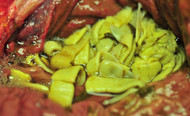Tapeworm Time and Horse Wormers
Posted by Ben Watson on 18th Sep 2015
As we approach tapeworm time it is important to remember that although traditionally the time to worm for this parasite have been around October and March it does not really matter when you treat as long as you do so roughly 6 months apart. The reason spring and autumn have been the times to use tapeworm horse wormers is to avoid re-infestation by the mite that infests horses with tapeworm. Modern theory is this mite is around and ingested by horses throughout the year so it does not really matter when the horse is wormed. However a great deal of worming programmes, and a lot of horse owners specify to worm horses for tapeworm in autumn and spring.
Tapeworm may be present in up to 69% of horses within the UK and although all horses are at risk of infection those aged less than 5 years old are most at risk. Tapeworm can grow from 4cm to 80cm in length and live at the junction between the large and small intestine so lare burdens of tapeworm can cause intestine blocking as well as spasmodic colic.
Tapeworm can be treated with a wormer containing either praziquantel or with a double dose of pyrantel embonate horse wormers. Equisal a new saliva tapeworm test is available and will be covered in another post shortly.

